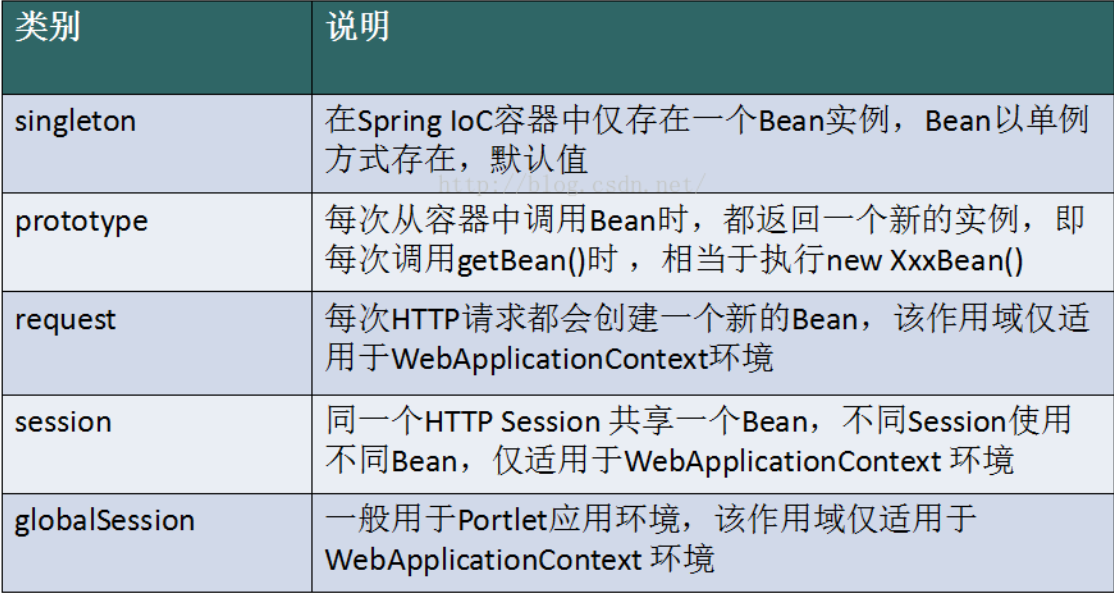Spring-依赖注入
一、概念
- 依赖注入(Dependency Injection,DI)。
- 依赖:指 Bean 对象的创建依赖于容器,Bean 对象的依赖资源 .
- 注入:指 Bean 对象所依赖的资源,由容器来设置和装配 .
二、构造器注入
我们在之前的案例已经讲过了
三、Set 注入(重点)
要求被注入的属性,必须有 set 方法,set 方法的方法名由 set + 属性首字母大写,如果属性是 boolean 类型,没有 set 方法,是 is
测试 pojo 类:
Address.java
public class Address {
private String address;
public String getAddress() {
return address;
}
public void setAddress(String address) {
this.address = address;
}
}Student.java
package com.kuang.pojo;
import java.util.List;
import java.util.Map;
import java.util.Properties;
import java.util.Set;
public class Student {
private String name;
private Address address;
private String[] books;
private List<String> hobbys;
private Map<String,String> card;
private Set<String> games;
private String wife;
private Properties info;
public void setName(String name) {
this.name = name;
}
public void setAddress(Address address) {
this.address = address;
}
public void setBooks(String[] books) {
this.books = books;
}
public void setHobbys(List<String> hobbys) {
this.hobbys = hobbys;
}
public void setCard(Map<String, String> card) {
this.card = card;
}
public void setGames(Set<String> games) {
this.games = games;
}
public void setWife(String wife) {
this.wife = wife;
}
public void setInfo(Properties info) {
this.info = info;
}
public void show(){
System.out.println("name="+ name + ",address="+ address.getAddress() + ",books=");
for (String book:books){
System.out.print("<<"+book+">>\t");
}
System.out.println("\n爱好:"+hobbys);
System.out.println("card:"+card);
System.out.println("games:"+games);
System.out.println("wife:"+wife);
System.out.println("info:"+info);
}
}1、常量注入
<bean id="student" class="com.kuang.pojo.Student">
<property name="name" value="小明"/>
</bean>测试:
@Test
public void test01(){
ApplicationContext context = new ClassPathXmlApplicationContext("applicationContext.xml");
Student student = (Student) context.getBean("student");
System.out.println(student.getName());
}2、Bean 注入
注意点:这里的值是一个引用,ref
<bean id="addr" class="com.kuang.pojo.Address">
<property name="address" value="重庆"/>
</bean>
<bean id="student" class="com.kuang.pojo.Student">
<property name="name" value="小明"/>
<property name="address" ref="addr"/>
</bean>3、数组注入
<bean id="student" class="com.kuang.pojo.Student">
<property name="name" value="小明"/>
<property name="address" ref="addr"/>
<property name="books">
<array>
<value>西游记</value>
<value>红楼梦</value>
<value>水浒传</value>
</array>
</property>
</bean>4、List 注入
<property name="hobbys">
<list>
<value>听歌</value>
<value>看电影</value>
<value>爬山</value>
</list>
</property>5、Map 注入
<property name="card">
<map>
<entry key="中国邮政" value="456456456465456"/>
<entry key="建设" value="1456682255511"/>
</map>
</property>6、Set 注入
<property name="games">
<set>
<value>LOL</value>
<value>BOB</value>
<value>COC</value>
</set>
</property>7、Null 注入
<property name="wife"><null/></property>8、Properties 注入
<property name="info">
<props>
<prop key="学号">20190604</prop>
<prop key="性别">男</prop>
<prop key="姓名">小明</prop>
</props>
</property>四、p 命名和 c 命名注入
User.java :【注意:这里没有有参构造器!】
public class User {
private String name;
private int age;
public void setName(String name) {
this.name = name;
}
public void setAge(int age) {
this.age = age;
}
@Override
public String toString() {
return "User{" +
"name='" + name + '\'' +
", age=" + age +
'}';
}
}1、P命名空间注入 : 需要在头文件中加入约束文件
导入约束 : xmlns:p="http://www.springframework.org/schema/p"
<!--P(属性: properties)命名空间 , 属性依然要设置set方法-->
<bean id="user" class="com.kuang.pojo.User" p:name="狂神" p:age="18"/>2、c 命名空间注入 : 需要在头文件中加入约束文件
导入约束 : xmlns:c="http://www.springframework.org/schema/c"
<!--C(构造: Constructor)命名空间 , 属性依然要设置set方法-->
<bean id="user" class="com.kuang.pojo.User" c:name="狂神" c:age="18"/>发现问题:爆红了,刚才我们没有写有参构造!
解决:把有参构造器加上,这里也能知道,c 就是所谓的构造器注入!
测试代码:
@Test
public void test02(){
ApplicationContext context = new ClassPathXmlApplicationContext("applicationContext.xml");
User user = (User) context.getBean("user");
System.out.println(user);
}五、依赖注入方式的选择
- 强制依赖使用构造器进行,使用 setter 注入有概率不进行注入导致 null 对象出现
- 可选依赖使用 setter 注入进行,灵活性强
- Spring 框架倡导使用构造器,第三方框架内部大多数采用构造器注入的形式进行数据初始化,相对严谨
- 如果有必要可以两者同时使用,使用构造器注入完成强制依赖的注入,使用 setter 注入完成可选依赖的注入
- 实际开发过程中还要根据实际情况分析,如果受控对象没有提供 setter 方法就必须使用构造器注入
- 自己开发的模块推荐使用 setter 注入
六、Bean 的作用域
在 Spring 中,那些组成应用程序的主体及由 Spring IoC 容器所管理的对象,被称之为 bean。简单地讲,bean 就是由 IoC 容器初始化、装配及管理的对象。

几种作用域中,request、session 作用域仅在基于 Web 的应用中使用(不必关心你所采用的是什么web应用框架),只能用在基于 Web 的 Spring ApplicationContext 环境。
1、Singleton
当一个 bean 的作用域为 Singleton,那么 Spring IoC 容器中只会存在一个共享的bean实例,并且所有对 bean 的请求,只要 id 与该 bean 定义相匹配,则只会返回 bean 的同一实例。
Singleton 是单例类型,就是在创建起容器时就同时自动创建了一个 bean 的对象,不管你是否使用,他都存在了,每次获取到的对象都是同一个对象。
注意,Singleton 作用域是 Spring中 的缺省作用域,也就是默认作用域。
要在 XML 中将 bean 定义成 singleton,可以这样配置:
<bean id="ServiceImpl" class="cn.csdn.service.ServiceImpl" scope="singleton">测试:
@Test
public void test03(){
ApplicationContext context = new ClassPathXmlApplicationContext("applicationContext.xml");
User user = (User) context.getBean("user");
User user2 = (User) context.getBean("user");
System.out.println(user==user2);
}2、Prototype
当一个 bean 的作用域为 Prototype,表示一个 bean 定义对应多个对象实例。
Prototype 作用域的 bean 会导致在每次对该 bean 请求(将其注入到另一个 bean 中,或者以程序的方式调用容器的 getBean() 方法)时都会创建一个新的 bean 实例。
Prototype 是原型类型,它在我们创建容器的时候并没有实例化,而是当我们获取 bean 的时候才会去创建一个对象,而且我们每次获取到的对象都不是同一个对象。
根据经验,对有状态的 bean 应该使用 prototype 作用域,而对无状态的 bean 则应该使用 singleton 作用域。
在 XML 中将 bean 定义成 prototype,可以这样配置:
<bean id="account" class="com.foo.DefaultAccount" scope="prototype"/>
或者
<bean id="account" class="com.foo.DefaultAccount" singleton="false"/>3、Request
当一个 bean 的作用域为 Request,表示在一次 HTTP 请求中,一个 bean 定义对应一个实例。
即每个HTTP请求都会有各自的bean实例,它们依据某个 bean 定义创建而成。该作用域仅在基于 web 的 Spring ApplicationContext 情形下有效。
考虑下面 bean 定义:
<bean id="loginAction" class=cn.csdn.LoginAction" scope="request"/>针对每次 HTTP 请求,Spring 容器会根据 loginAction bean 的定义创建一个全新的 LoginAction bean 实例,且该 loginAction bean 实例仅在当前 HTTP request 内有效,因此可以根据需要放心的更改所建实例的内部状态,而其他请求中根据 loginAction bean 定义创建的实例,将不会看到这些特定于某个请求的状态变化。当处理请求结束,request 作用域的bean实例将被销毁。
4、Session
当一个bean的作用域为 Session,表示在一个 HTTP Session 中,一个bean定义对应一个实例。该作用域仅在基于web的Spring ApplicationContext 情形下有效。考虑下面bean定义:
<bean id="userPreferences" class="com.foo.UserPreferences" scope="session"/>针对某个HTTP Session,Spring容器会根据userPreferences bean定义创建一个全新的userPreferences bean实例,且该userPreferences bean仅在当前HTTP Session内有效。与request作用域一样,可以根据需要放心的更改所创建实例的内部状态,而别的HTTP Session中根据userPreferences创建的实例,将不会看到这些特定于某个HTTP Session的状态变化。当HTTP Session最终被废弃的时候,在该HTTP Session作用域内的bean也会被废弃掉。

